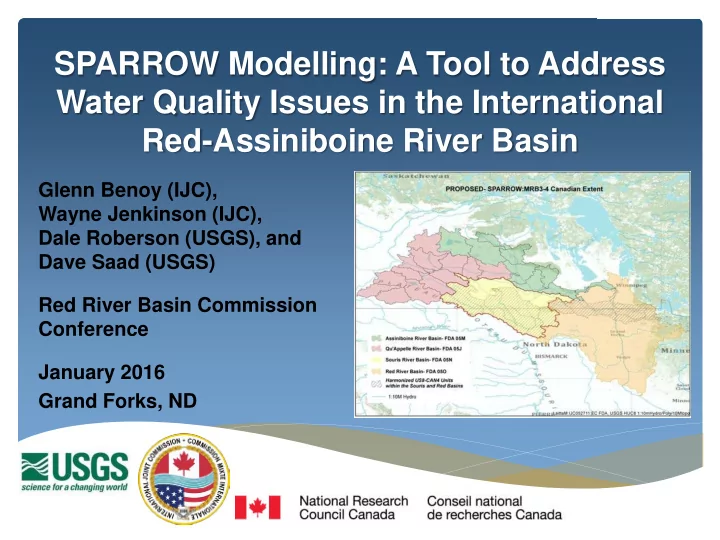

SPARROW Modelling: A Tool to Address Water Quality Issues in the International Red-Assiniboine River Basin Glenn Benoy (IJC), Wayne Jenkinson (IJC), Dale Roberson (USGS), and Dave Saad (USGS) Red River Basin Commission Conference January 2016 Grand Forks, ND
Presentation Outline ∗ A Short History of the IJC… ∗ The IJC’s International Watersheds Initiative and Water Quality Modelling ∗ Nutrient Enrichment and Eutrophication in the Red- Assiniboine River Basin ∗ The SPARROW Water Quality Model ∗ Red-Assiniboine Model Output and the Mapper (Online Tool) ∗ What’s Next for Red-Assiniboine SPARROW Modelling? 2 2016-08-05
Mandate and History of the International Joint Commission Turn of the 20 th century disputes: Apportionment of water for irrigation in the St. Mary and Milk rivers Sewage and manufacturing wastes that led to outbreaks of cholera among other water-borne public health problems 3 2016-08-05
Mandate and History of the International Joint Commission Role of the IJC Regulating shared water uses Investigating transboundary issues and recommending solutions The IJC is guided by the Boundary Waters Treaty of 1909 Includes the requirement “that neither country should cause water pollution in its water which will cause injury to health or property in the other country” (Article IV, section 2) One of the earliest proactive and continuous references to water pollution in the world 4 2016-08-05
Boards of the IJC International Souris River Board International Red River Board “Mandate…to prevent and resolve “Mandate…to prevent and resolve transboundary disputes and transboundary disputes regarding ensure a more eco-systemic the waters and aquatic ecosystem approach to transboundary water of the Red River and its tributaries issues, compliance for and aquifers” apportionment of river flows, and “Activities shall focus on…water oversight of flood operations” quality, water quantity and levels, and aquatic ecological integrity” 5 2016-08-05
The International Watersheds Initiative and Water Quality Modelling “The IWI is guided by an integrated, ecosystem approach that recognizes the complex interrelationships in the entire watershed.” Major initiatives and activities Hydrographic and Geospatial Data Harmonization Task Force Binational Water Quality Modelling Water Hydraulic Hydrologic Ecological Quality 6
Data Harmonization Souris River Basin (ND, MB, SK) Harmonized Basin and Sub-basins Gauges Pre-harmonization (NHN-NHD) 7 2016-08-05
Water Quality Modelling 10 000s Spatially-Referenced SPARROW SPARROW Regressions on Watershed attributes GWLF GWLF Generalized Watershed Area (km 2 ) Loading Function SWAT SWAT Soil and Water HSPF Assessment Tool HSPF Hydrology Simulation <1 Program-FORTRAN Yearly Hourly Time 8 2016-08-05
Nutrient Enrichment and Eutrophication in the Red- Assiniboine River Basin 9 2016-08-05
Increasing frequency and severity of algal blooms in Lake Winnipeg and in lakes and reservoirs across the international Red and Souris River watersheds Average Total Phosphorus Load (tonnes per year (per cent contribution)) Pelican Lake, Buffalo Red Pembina River watershed watershed Homme Dam, North Dakota 1994 to 2007 – Conservation and Water Stewardship 10
Eutrophication A Water Quality Issue Across the Transboundary Driving forces and pressures ∗ Farm policy and the intensification of agriculture ∗ Fertilizer and manure applications in cropping systems ∗ Livestock operations (Concentrated Animal Feeding Operations, CAFOs) ∗ Landscape hardening (impervious surfaces, soil organic matter and permeability, wetlands) ∗ Aging urban and rural infrastructure ∗ Climate change and altered temperature and precipitation regimes ∗ Historical legacy of human activities (e.g. sediment burial) 11 2016-08-05
The SPARROW Water Quality Model 12 2016-08-05
Binational Water Quality Modelling SPAtially-Referenced Regressions On Watershed attributes (SPARROW) SPARROW relates long-term trends in water quality to large-scale descriptors of human activities, climate, hydrology, geology and physiography AND land-to-water and instream decay delivery processes 13 2016-08-05
SPARROW Modelling Team – Multidisciplinary and Multi-agency Agency Contributors International Joint Commission Glenn Benoy, Wayne Jenkinson, Mike Laitta USGS (+ state agencies) Donna Myers, Craig Johnston, Dale Robertson, Dave Saad National Research Council of Ivana Vouk, Martin Serrer, Richard Burcher Canada Environment Canada Erika Klyzsejko, Craig McCrimmon Agriculture & Agri-Food Canada Jason Vanrobaeys, Pamela Joosse Manitoba Conservation and Elaine Page, Justin Shead, Sharon Gurney Water Stewardship Statistics Canada Mark Henry, Francois Soulard Saskatchewan Water Security / O.S.(Arasu) Thirunkavukkarasu, Pam Minifie Environment 2016-08-05
Red-Assiniboine Model: Four Key Datasets Monitoring stations Stream network Model Development Sources Land-to-water delivery
Red-Assiniboine SPARROW Nutrient Models: Calibration (observed vs predicted flux) Total phosphorus Total nitrogen
Red-Assiniboine SPARROW Nutrient Models: Calibration *** Preliminary Results *** Red/Assiniboine Phosphorus SPARROW Model Phosphorus Sources Coefficient P value Agriculture (fertilizer plus manure) 0.011 0.003 Point Sources 1.000 . Forest and Wetlands 6.016 0.033 Channels (Medium sized 5-50 cfs) 0.070 0.040 Land-to-Water Delivery Precipitation 0.070 0.000 Decay Reservoirs 5.734 0.029 Model Statistics RMSE 0.489 Adj r2 0.915 Yield R2 0.815 N 104 **Note: Point sources not estimated by model
Red-Assiniboine SPARROW Nutrient Models: Calibration *** Preliminary Results *** Red/Assiniboine Nitrogen SPARROW Model Nitrogen Sources Coefficient P value Agriculture (fertilizer plus manure) 0.032 0.004 Point Sources 1.000 . Atmosphere 0.032 . Land-to-Water Delivery Precipitation 0.014 0.000 Air Temperature -0.573 0.000 Decay Streams (continuous decay) 0.046 0.393 Reservoirs 1.809 0.151 Model Statistics RMSE 0.44 Adj R2 0.93 Yield R2 0.876 N 75 **Note: Point sources and atmospheric deposition not estimated by model
SPARROW N and P Models *** Preliminary Results *** Sources of phosphorus Sources of nitrogen (%) (%) 19
What’s Next for Red-Assiniboine SPARROW Modelling? North and South Saskatchewan ∗ Technology training and transfer Rivers Winnipeg R: Rainy R and Lake of the to interested agencies and Woods organizations ∗ Updating the “base” year from 2002 to 2012 ∗ Comparing SPARROW model Great Lakes Model output with other models being Lake Winnipeg Basin applied in the basin (e.g. SWAT, HSPF) ∗ Geographic expansion to include neighbouring watersheds 20 2016-08-05
Thank you…questions? Dr. Glenn Benoy SPARROW benoyg@ottawa.ijc.org http://water.usgs.gov/nawqa/sparrow/ (Fact Sheet, FAQs)
Recommend
More recommend